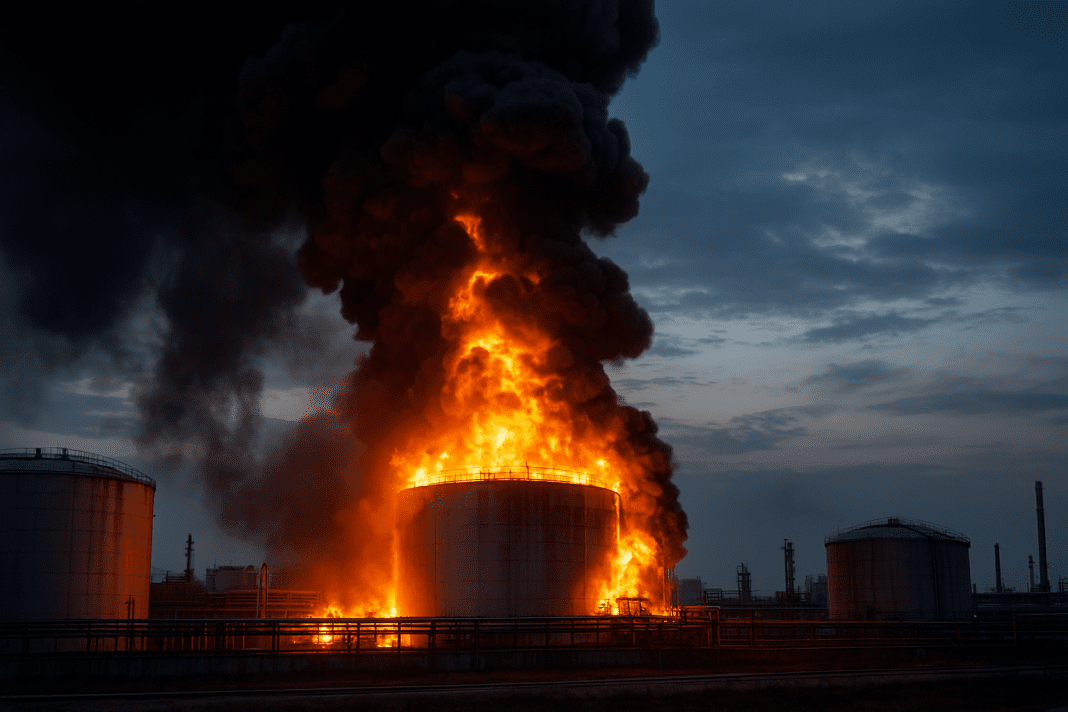A massive wave of drone attacks struck several regions across Russia early Wednesday, setting off industrial explosions and fires at key oil and chemical facilities. The strikes caused major disruptions, temporary flight suspensions, and widespread alarm as explosions lit up the skies from Moscow to the North Caucasus.
Widespread Drone Attacks Ignite Industrial Explosions Across Regions
According to monitoring channels, between 100 and 130 drones were observed flying across Russian territory late Tuesday night. By early Wednesday morning, airspace restrictions were enforced at several airports, including Vladikavkaz, Grozny, and Samara. The attacks marked one of the largest coordinated drone offensives seen in months.
Residents in several cities reported hearing loud industrial explosions and witnessing fires that spread quickly after impact. Videos circulating online showed massive flames rising from industrial areas, with black smoke visible for miles.
NATO Betrayed? Hungary Pumps Billions Into Moscow’s War Chest With 86% Russian Oil Dependence
Operations at Moscow’s Domodedovo and Zhukovsky airports were temporarily suspended as a safety measure. Flight activities later resumed, but travelers faced delays and diversions as authorities assessed the scale of the attack.
In the Ulyanovsk region, powerful industrial explosions were reported around 12:20 a.m. local time near Novospasskoye. Soon after, footage showed a large blaze at an oil depot, which was later identified by local media as belonging to NS-Oil OJSC. The fire burned for several hours before emergency crews managed to contain it.
Energy Infrastructure Damaged by Drone Strikes
The strikes also hit several industrial and energy-related facilities, triggering multiple industrial explosions that targeted Russia’s vital oil and petrochemical sectors. In the Stavropol Territory, drones reportedly attacked a major petrochemical plant operated by Stavrolen LLC. This facility is known for producing key materials such as polyethylene and benzene, both essential for industrial manufacturing.
Shortly afterward, around 2 a.m., another round of industrial explosions was reported in the Republic of Mari El. Drones struck the Mari Oil Refinery, with bright flashes captured in multiple videos shared on regional media platforms. Witnesses described the impact as “intense” and said it caused visible shockwaves in nearby residential areas.
Russia’s Ministry of Defense confirmed that 100 Ukrainian fixed-wing drones were intercepted and destroyed overnight. However, reports from various regions indicated that several drones still managed to reach their intended targets.
UK targets Russian oil giants and Nayara Energy in new sanctions aimed at cutting Kremlin revenue
According to official data, drone interceptions occurred over multiple regions:
46 drones over Bryansk,
12 over Kaluga,
8 over Belgorod,
7 over Krasnodar,
6 each over Moscow and Oryol,
4 over Ulyanovsk,
3 each over Crimea and Mari El,
2 over Stavropol,
1 each over Kursk, Smolensk, and Tula.
Despite these interceptions, several industrial facilities sustained visible damage. Fires at refineries and depots highlighted how the industrial explosions continue to pressure Russia’s energy sector. Drone fragments were found scattered across fields and near highways, suggesting a wide strike radius.
Emergency response teams were deployed to affected areas throughout the night. Local authorities restricted movement around industrial zones as firefighters battled flames and prevented further industrial explosions from spreading to storage tanks. No official reports of casualties were released at the time of reporting.
Economic Strain Grows as Industrial Explosions Disrupt Energy Supply
The latest drone wave adds to a series of attacks that have increasingly targeted Russia’s fuel and energy infrastructure, leading to repeated industrial explosions and disruptions across the country. These operations have interrupted refinery production, damaged oil storage sites, and strained domestic fuel supplies.
Independent reports indicate that several oil refineries have been forced to halt or limit operations following these industrial explosions. With major plants temporarily shut down, authorities have had to redistribute refining work to other locations, creating logistical bottlenecks.
Alarming surge in mysterious Russian oil deaths sparks fears of secret pressure plots
Economic data shows a major impact, with fuel prices rising 2.6% in September — the sharpest increase since 2018. Annual inflation has reached 12.7%, the highest in over a decade.
Repeated industrial explosions have reduced Russia’s refining capacity by about one-fifth, with up to 27% of fuel production affected. The shortfall has caused fuel queues and shortages in several regions.
The attacks have also pushed Moscow to rely more on imports from Belarus, China, and other Asian suppliers, while higher transport costs add to market pressure. Despite stronger air defenses, frequent drone strikes continue to trigger industrial explosions and disrupt key energy and petrochemical facilities.
